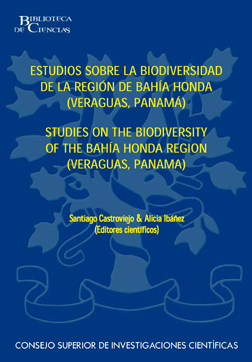
Subjects 
- Archaeology and Prehistory (161)
- Arts and Architecture (240)
- Earth Sciences (95)
- History and Historiography (302)
- History of Science (101)
- Information and Library Sciences (80)
- Life Sciences (170)
- Linguistics and Philology (100)
- Literature and Literary Criticism (133)
- Philosophy and Religion (110)
- Popular Science (257)
- Science and Technology (145)
- Social Sciences (152)
Collections 
Authors 
Send a friend 
Estudios sobre la biodiversidad de la región de Bahía Honda (Veraguas, Panamá) = Studies on the biodiversity of the Bahía Honda Region (Veraguas, Panama)
  Santiago Castroviejo (edicion) Affiliation: Not available Biography: Not available Alicia Ibáñez (edicion) Affiliation: Not available Biography: Not available |
Edition: Santiago Castroviejo; Alicia Ibáñez Publication year: 2005 Language: spanish; english Subjects: Life Sciences Collection: Biblioteca de Ciencias |
Abstract:
The Bahía Honda region presents a situation typical of a good part of the Central American lowlands: forests cleared, vegetation affected by the sequence of pasture/burning/pasture, rivers contaminated, poor cultivation still by traditional means, with limited access to fertilizers, insecticides, herbicides, pesticides, and so on, and a gradual exodus from rural areas. All this adds up to create a region of special interest. In spite of its apparent degradation, most of the original flora and fauna still survives in fragments of woodland. So here we have a scarcely populated territory, degraded to some extent, but with refuges of the original flora and fauna. Under these circumstances, the directors of the company, Bahía Honda LDC, decided to organize programs of study and regeneration of the environment. This project is a pathbreaking study of the Central American tropical environment, aimed at finding solutions to combine reasonable development with intelligent environmental protection. The first step toward the launching of this program was all too clear: to collect basic information about the flora and fauna that would enable the experts to proceed with their plans on a firm footing – to acquire the first data upon which to build the pyramid of knowledge – a catalogue raisonné of the flora and fauna. Focusing on the terrestrial environment, we saw that we should begin with a catalog of vertebrates (amphibians, reptiles, birds and mammals) and forest species (vascular plants, bryophytes and lichens), as well as some groups of invertebrates (insects, poisonous arthropods, etc.). The present study follows this line of reasoning.
Bibliographic information
Physical Description : 835 p. : il., gráf., mapas ; 24 cm
ISBN: 978-84-00-08405-9
eISBN: 978-84-00-09622-9
Publication: Madrid : Consejo Superior de Investigaciones Científicas, 2005
Reference CSIC: 11143
Buy the digital edition at- e-libro Buy the print edition at |
Free DownloadsNo downloads available |
This book was added to our online catalog on Monday 08 April, 2013.







